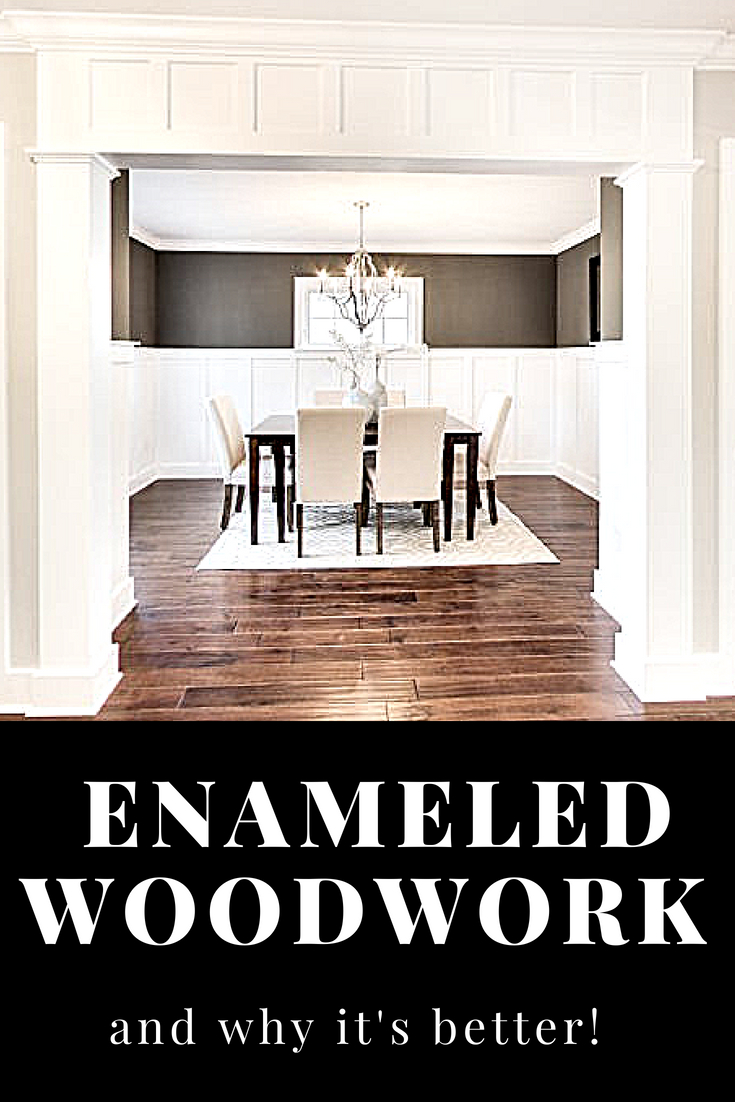What is Enameled Woodwork and Why is it Better?
It’s no secret that we love enameled woodwork in the homes we built and remodel.
I like to think of myself as a realist. I know we all want to keep our homes perfectly clean and plan to be careful in how we navigate our space.
I also know that realistically we all have dirty hands at times, forget to remove our shoes, or accidentally bump into walls.
With white woodwork being so popular, it can be easier to see the imperfections caused by everyday living in our homes.
As a result of being realistic about how our homes are used, we made the decision a long time ago to enamel all of our woodwork in our projects.
Affiliate Disclosure: You should assume the owner of this website has an affiliate relationship and/or another material connection, to any suppliers of goods and services that may be discussed here and may be compensated for showing advertisements or recommending products or services, or linking to the supplier's website.
What is Enameled Woodwork?
Simply put, to have enameled woodwork or trim means that it has been coated or painted with an enamel paint.
What is Enamel Paint?
An enamel paint is known for having a glossy finish, being very hard, and is washable.
For the ease of explaining, there are basically two kinds of enamel paint: oil based and water based.
Oil based enamel paints have a harder finish and longer dry times. Water based are faster drying, less odor, easier to apply and easier to clean up if it gets where it isn't supposed to be.
Enamel paints are currently available in a wide variety of sheens from eggshell to high gloss.
A general rule of thumb is: the glossier the sheen, the more durable the enamel will be.
Enamel paints can also be found in just about any color you could imagine!
Why is Enameling Woodwork Better Than Just Painting It?
Enamel paint is much more durable than standard paint used on a wall.
The durability of enamels makes them perfect for areas that get a lot of use or heavy traffic.
This includes kitchen cabinets, bathroom vanities, stair risers, base and casing, stair railings, wainscoting, chair rails, and interior doors.
Finger prints from dirty hands are easily cleaned off enameled woodwork, cabinet doors, and railings.
Enameled woodwork can also handle higher humidity and is mildew resistant which makes it a good choice for bathrooms and for use on casing around windows in showers.
It will help prevent rot of wooden surfaces while still being easy to clean.
Enameling a fireplace mantel can also help it withstand being close to higher heat with less expansion and contraction.
There are enamel paints that are even made with extra heat resistant properties!
Enamel paints are less likely to chip, have exceptional coverage, and can be washed frequently and still look great!
How is Enamel Applied to Woodwork?
Enamel paint has superior coverage to other paints and can be easily applied with a number of techniques.
High quality brushes, paint rollers, and paint sprayers are all acceptable methods to apply enamel paint.
Keep in mind that high gloss finishes show imperfections, so if you are applying the enamel paint yourself, preparation is key.
Cleaning your woodwork, sanding it smooth, filling any holes with wood putty, and caulking seams and gaps, are all important steps to make sure the surface is ready for the enamel.
Applying multiple thin coats will ensure you have good coverage and a consistent finish.
If there are drips or other imperfections noted between coats, make sure to fill/sand/caulk to correct the issue before adding a another coat.
We have had the highest success getting a smooth finish when the enamel is applied using a sprayer.
This requires a significant amount of preparation in order to make sure the enamel does not get on adjacent surfaces.
Most professional painters are familiar with how to do this exceptionally well.
What is the Cost Difference Between Painted and Enameled Woodwork?
If you plan to enamel your woodwork yourself, the cost difference will be mostly in materials.
It is roughly $10-$30 for a gallon of regular white wall paint compared to $35-$85 for a gallon of white enamel paint.
The difference for a total project would probably be a few hundred dollars.
If you're hiring a professional painter who intends to spray the woodwork, there will be additional cost to consider.
Much of this additional cost comes from the amount of labor involved in the preparation to spray the space.
We have found this extra cost to be well worth it to have a consistent finish and overall better outcome that will last and look great for years to come.
To spray all of the trim and interior doors with enamel paint in a home that is roughly 2,500 square feet we see an average between $3,000-5,000.
The price can depend on the painter's experience, the amount of trim and doors, and if there are additional features such as a fireplace mantel, wainscoting, or multiple colors they have to apply.
Conclusion
The functional benefits including durability and being washed easily are important when considering enameling woodwork.
Personally, I also love the style!
The clean look of white trim and a beautiful glossy finish really shows off the detail in woodwork.
The extra cost and work involved is really an investment in making a home easier to maintain and clean.
Did you paint your woodwork or is it enameled? What other questions do you have? Drop them below!
Cover Photography by Lauren Lutterman Photography https://www.photosbylaurenl.com




















